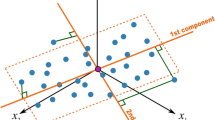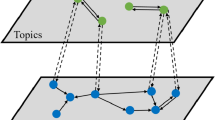Abstract
Information propagation in social media depends not only on the static follower structure but also on the topic-specific user behavior. Hence, novel models incorporating dynamic user behavior are needed. To this end, we propose a model for individual social media users, termed a genotype. The genotype is a per-topic summary of a user’s interest, activity and susceptibility to adopt new information. We demonstrate that user genotypes remain invariant within a topic by adopting them for classification of new information spread in large-scale real networks. Furthermore, we extract topic-specific influence backbone structures based on content adoption and show that their structure differs significantly from the static follower network. We also find, at the population level using a simple contagion model, that hashtags of a known topic propagate at the greatest rate on backbone networks of the same topic. When employed for influence prediction of new content spread, our genotype model and influence backbones enable more than 20 % improvement, compared to purely structural features. It is also demonstrated that knowledge of user genotypes and influence backbones allows for the design of effective strategies for latency minimization of topic-specific information spread.










Similar content being viewed by others
References
Bandari R, Asur S, Huberman BA (2012) The pulse of news in social media: forecasting popularity, in ICWSM
Bakshy E, Hofman JM, Mason WA, Watts DJ (2011) Everyone’s an influencer: quantifying influence on Twitter. In: WSDM
Bakshy E, Rosenn I, Marlow C, Adamic L (2012) The role of social networks in information diffusion. In: WWW p 519–528
Bogdanov P, Busch M, Moehlis J, Singh AK, Szymanski BK (2013) The social media genome: modeling individual topic-specific behavior in social media, in ASONAM
Blei DM, Ng AY, Jordan MI (2003) Latent Dirichlet allocation. J Mach Learn Res 3:993–1022
Brin S, Page L (1998) The anatomy of a large-scale hypertextual web search engine. Comput Netw ISDN Syst 30(1):107–117
Dodds P, Harris K, Kloumann I, Bliss C, Danforth C (2011) Temporal patterns of happiness and information in a global social network: Hedonometrics and Twitter. PLoS One 6(12):e26752
De Choudhury M (2011) Tie formation on Twitter: homophily and structure of egocentric networks. In: PASSAT and SocialCom. IEEE p 465–470
Friedkin N (2006) A structural theory of social influence. vol. 13. Cambridge University Press, Cambridge, UK
Gomez Rodriguez M, Leskovec J, Schölkopf B (2013) Structure and dynamics of information pathways in online media. In: WSDM, p 23–32
Gulli A (2012) News space. http://www.di.unipi.it/~gulli/. Accessed July 2012
Hethcote H (2000) The mathematics of infectious diseases. SIAM Rev 42(4):599–653
Kempe D, Kleinberg J, Tardos E (2003) Maximizing the spread of influence through a social network, in SIGKDD, p 137–146
Kimura M, Saito K, Nakano R, Motoda H (2010) Extracting influential nodes on a social network for information diffusion, DMKD
Kwak H, Lee C, Park H, Moon S (2010) What is Twitter, a social network or a news media? in WWW, p 591–600
Lehmann J, Gonçalves B, Ramasco JJ, Cattuto C (2012) Dynamical classes of collective attention in Twitter. In: WWW. ACM, p 251–260
Lin CX, Mei Q, Jiang Y, Han J, Qi S (2011) Inferring the diffusion and evolution of topics in social communities, SNMA
McCallum AK (2002) MALLET: a machine learning for language toolkit. http://mallet.cs.umass.edu . Accessed July 2012
Meyerson A, Tagiku B (2009) Minimizing average shortest path distances via shortcut edge addition. In: APPROX/RANDOM, p 272–285
Newman MEJ (2003) The structure and function of complex networks. SIAM Rev 45:167–256
Pal A, Counts S (2011) Identifying topical authorities in microblogs. In: WSDM p 45–54
Romero DM, Meeder B, Kleinberg J (2011) Differences in the mechanics of information diffusion across topics: idioms, political hashtags, and complex contagion on Twitter, in WWW, p 695–704
Ramage D, Dumais S, Liebling D (2010) Characterizing microblogs with topic models. ICWSM 5(4):130–137
Reali F, Griffiths TL (2010) Words as alleles: connecting language evolution with Bayesian learners to models of genetic drift. Proc Royal Soc B Biol Sci 277(1680):429–436
Ribiero R (2012) 25 small-business Twitter hashtags to follow. http://www.biztechmagazine.com/article/2012/06/25-small-business-twitter-hashtags-follow. Accessed July 2012
Rennie J (2008) 20 newsgroups. http://www.qwone.com/~jason/20Newsgroups/. Accessed July 2012
Suh B, Hong L, Pirolli P, Chi E (2010) Want to be retweeted? large scale analytics on factors impacting retweet in Twitter network, in SocialCom, p 177–184
Tsur O, Rappoport A (2012) What’s in a hashtag?: content based prediction of the spread of ideas in microblogging communities, in WSDM, p 643–652
Weng J, Lim E-P, Jiang J, He Q (2010) TwitterRank: finding topic-sensitive influential Twitterers, in WSDM, p 261–270
Yang J, Leskovec J (2011) Patterns of temporal variation in online media, in WSDM, p 177–186
Acknowledgments
This work was supported by the Institute for Collaborative Biotechnologies through grant W911NF-09-0001 from the U.S. Army Research Office and by the Army Research Laboratory under cooperative agreement W911NF-09-2-0053 (NS-CTA). The content of the information does not necessarily reflect the position or the policy of the Government, and no official endorsement should be inferred. The U.S. Government is authorized to reproduce and distribute reprints for Government purposes notwithstanding any copyright notice herein.
Author information
Authors and Affiliations
Corresponding author
Additional information
P. Bogdanov and M. Busch contributed equally.
This manuscript is an extension of the authors’ earlier work presented at the 2013 IEEE/ACM International Conference on Advances in Social Networks Analysis and Mining (ASONAM). Here, the original ideas and methods are explained in further detail along with previously unpublished results.
Rights and permissions
About this article
Cite this article
Bogdanov, P., Busch, M., Moehlis, J. et al. Modeling individual topic-specific behavior and influence backbone networks in social media. Soc. Netw. Anal. Min. 4, 204 (2014). https://doi.org/10.1007/s13278-014-0204-6
Received:
Revised:
Accepted:
Published:
DOI: https://doi.org/10.1007/s13278-014-0204-6




